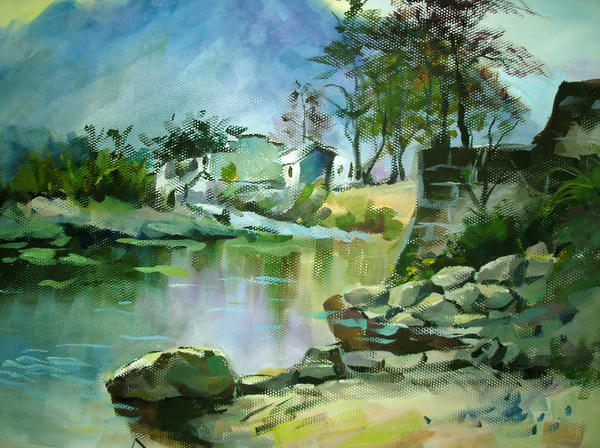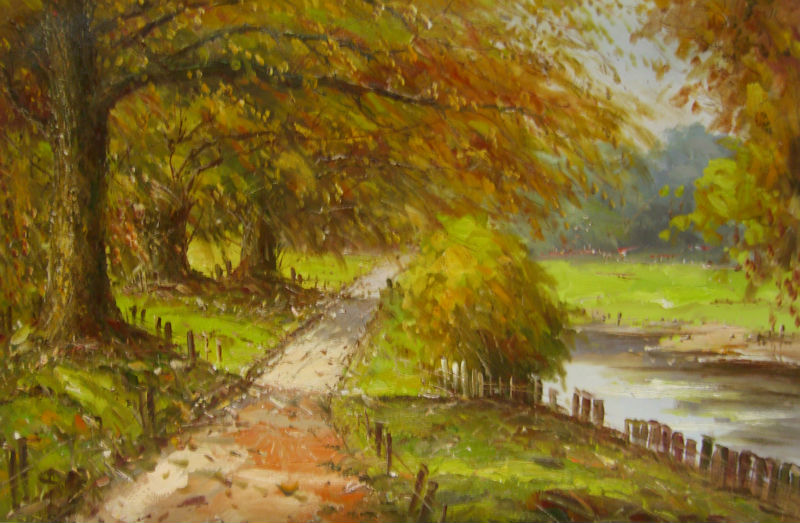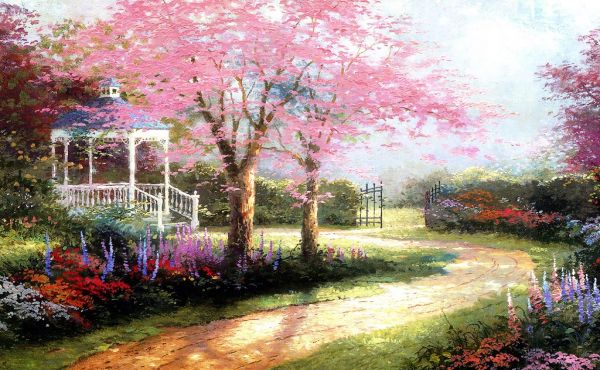Painting Of Nature Scenery Biography
(Source google.com)
Painting nature scenery art is the depiction in art of landscapes, natural scenery such as mountains, valleys, trees, rivers, and forests, and especially art where the main subject is a wide view, with its elements arranged into a coherent composition. In other works landscape backgrounds for figures can still form an important part of the work. Sky is almost always included in the view, and weather is often an element of the composition. Detailed landscapes as a distinct subject are not found in all artistic traditions, and develop when there is already a sophisticated tradition of representing other subjects. The two main traditions spring from Western painting and Chinese art, going back well over a thousand years in both cases. Landscape photography has been very important since the 19th century, and is covered by its own article. The recognition of a spiritual element in landscape art is present form its beginnings in East Asian art, drawing on Daoism and other philosophical traditions, but in the West only becomes explicit with Romanticism.
The word "landscape" entered the modern English language as landskip(variously spelt), an anglicization of the Dutch landschap, around the start of the 17th century, purely as a term for works of art, with its first use as a word for a painting in 1598. Within a few decades it was used to describe vistas in poetry, and eventually as a term for real views. However the cognate termlandscaef or landskipe for a cleared patch of land had existed in Old English, though it is not recorded from Middle English. Landscape views in art may be entirely imaginary, or copied from reality with varying degrees of accuracy. If the primary purpose of a picture is to depict an actual, specific place, especially including buildings prominently, it is called a topographical view. Such views, extremely common as prints in the West, are often seen as inferior to fine art landscapes, although the distinction is not always meaningful; similar prejudices existed in Chinese art, where literati painting usually depicted imaginary views, while professional court artists painted real views, often including palaces and cities.
The earliest forms of art around the world depict little that could really be called landscape, although ground-lines and sometimes indications of mountains, trees or other natural features are included. The earliest "pure landscapes" with no human figures are frescos from Minoan Greece of around 1500 BCE.[6]Hunting scenes, especially those set in the enclosed vista of the reed beds of the Nile Delta from Ancient Egypt, can give a strong sense of place, but the emphasis is on individual plant forms and human and animal figures rather than the overall landscape setting. For a coherent depiction of a whole landscape, some rough system of perspective, or scaling for distance, is needed, and this seems from literary evidence to have first been developed in Ancient Greece in the Hellenistic period, although no large-scale examples survive. More ancient Roman landscapes survive, from the 1st century BCE onwards, especially frescos of landscapes decorating rooms that have been preserved at archaeological sites of Pompeii, Herculaneum and elsewhere, and mosaics.
The Chinese ink painting tradition of shan shui ("mountain-water"), or "pure" landscape, in which the only sign of human life is usually a sage, or a glimpse of his hut, uses sophisticated landscape backgrounds to figure subjects, and landscape art of this period retains a classic and much-imitated status within the Chinese tradition. Both the Roman and Chinese traditions typically show grand panoramas of imaginary landscapes, generally backed with a range of spectacular mountains – in China often with waterfalls and in Rome often including sea, lakes or rivers. These were frequently used, as in the example illustrated, to bridge the gap between a foreground scene with figures and a distant panoramic vista, a persistent problem for landscape artists. The Chinese style generally showed only a distant view, or used dead ground or mist to avoid that difficulty.
A major contrast between landscape painting in the West and East Asia has been that while in the West until the 19th century it occupied a low position in the accepted hierarchy of genres, in East Asia the classic Chinese mountain-water ink painting was traditionally the most prestigious form of visual art. Aesthetic theories in both regions gave the highest status to the works seen to require the most imagination from the artist. In the West this was history painting, but in East Asia it was the imaginary landscape, where famous practitioners were, at least in theory, amateur literati, including several Emperors of both China and Japan. They were often also poets whose lines and images illustrated each other. However in the West, history painting came to require an extensive landscape background where appropriate, so the theory did not entirely work against the development of landscape painting – for several centuries landscapes were regularly promoted to the status of history painting by the addition of small figures to make a narrative scene, typically religious or mythological.
Painting Of Nature Scenery Pintings of Nature Abstract on Canvas for Kids Scenes Love Beauty and Environment Wallpapers Easy Scenery

Painting Of Nature Scenery Pintings of Nature Abstract on Canvas for Kids Scenes Love Beauty and Environment Wallpapers Easy Scenery
Painting Of Nature Scenery Pintings of Nature Abstract on Canvas for Kids Scenes Love Beauty and Environment Wallpapers Easy Scenery
Painting Of Nature Scenery Pintings of Nature Abstract on Canvas for Kids Scenes Love Beauty and Environment Wallpapers Easy Scenery

Painting Of Nature Scenery Pintings of Nature Abstract on Canvas for Kids Scenes Love Beauty and Environment Wallpapers Easy Scenery

Painting Of Nature Scenery Pintings of Nature Abstract on Canvas for Kids Scenes Love Beauty and Environment Wallpapers Easy Scenery

Painting Of Nature Scenery Pintings of Nature Abstract on Canvas for Kids Scenes Love Beauty and Environment Wallpapers Easy Scenery

Painting Of Nature Scenery Pintings of Nature Abstract on Canvas for Kids Scenes Love Beauty and Environment Wallpapers Easy Scenery
Painting Of Nature Scenery Pintings of Nature Abstract on Canvas for Kids Scenes Love Beauty and Environment Wallpapers Easy Scenery
Painting Of Nature Scenery Pintings of Nature Abstract on Canvas for Kids Scenes Love Beauty and Environment Wallpapers Easy Scenery

Painting Of Nature Scenery Pintings of Nature Abstract on Canvas for Kids Scenes Love Beauty and Environment Wallpapers Easy Scenery
Painting Of Nature Scenery Pintings of Nature Abstract on Canvas for Kids Scenes Love Beauty and Environment Wallpapers Easy Scenery

Painting Of Nature Scenery Pintings of Nature Abstract on Canvas for Kids Scenes Love Beauty and Environment Wallpapers Easy Scenery

Painting Of Nature Scenery Pintings of Nature Abstract on Canvas for Kids Scenes Love Beauty and Environment Wallpapers Easy Scenery

No comments:
Post a Comment